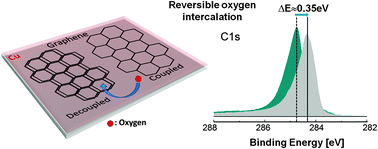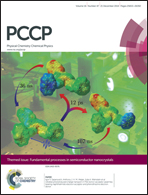The influence of intercalated oxygen on the properties of graphene on polycrystalline Cu under various environmental conditions†
Abstract
Intercalation of oxygen at the interface of graphene grown by chemical vapour deposition and its polycrystalline copper catalyst can have a strong impact on the electronic, chemical and structural properties of both the graphene and the Cu. This can affect the oxidation resistance of the metal as well as subsequent graphene transfer. Here, we show, using near ambient pressure X-ray photoelectron spectroscopy (NAP-XPS), X-ray absorption near edge spectroscopy (XANES), energy dispersive X-ray spectroscopy (EDX) and (environmental) scanning electron microscopy (ESEM) that both the oxygen intercalation and de-intercalation are kinetically driven and can be clearly distinguished from carbon etching. The obtained results reveal that a charge transfer between as grown graphene and Cu can be annulled by intercalating oxygen creating quasi-free-standing graphene. This effect is found to be reversible on vacuum annealing proceeding via graphene grain boundaries and defects within the graphene but not without loss of graphene by oxidative etching for repeated (de-)intercalation cycles.


 Please wait while we load your content...
Please wait while we load your content...